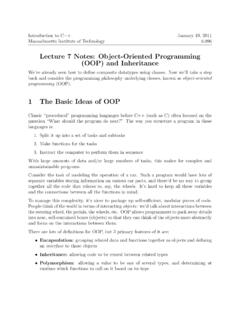Transcription of MIT6 0001F16 Object Oriented Programming
1 Object Oriented Programming (download slides and .pyfiles follow along!)6 . 0 0 0 1 L E C T U R E LECTURE 81 OBJECTS Python supports many different kinds of "Hello"[1, 5, 7, 11, 13]{"CA": "California", "MA": "Massachusetts"} each is an Object , and every Object has: a type an internal data representation(primitive or composite) a set of procedures for interactionwith the Object an Object is an instanceof a type 1234 is an instance of an int "hello"is an instance of a LECTURE 82 Object Oriented Programming (OOP) EVERYTHING IN PYTHON IS AN Object (and has a type) can create new objects of some type can manipulate objects can destroy objects explicitly using delor just forget about them python system will reclaim destroyed or inaccessible objects called garbage collection LECTURE 83 WHAT ARE OBJECTS? objects are a data abstractionthat (1) an internal representation through data attributes(2) an interfacefor interacting with Object through methods (aka procedures/functions) defines behaviors but hides LECTURE 84 how are lists represented internally?
2 Linked list of cellsL = how to manipulatelists? L[i], L[i:j], + len(), min(), max(), del(L[i]) (), (), (), (), (), (), (), (), () internal representation should be private correct behavior may be compromised if you manipulate internal representation directlyEXAMPLE: [1,2,3,4] has type LECTURE 851 -> 2 ->3 ->4 ->ADVANTAGES OF OOP bundle data into packages together with procedures that work on them through well-defined interfaces divide-and-conquerdevelopment implement and test behavior of each class separately increased modularity reduces complexity classes make it easy to reusecode many Python modules define new classes each class has a separate environment (no collision on function names) inheritance allows subclasses to redefine or extend a selected subset of a superclass LECTURE 86 make a distinction between creating a class and using an instance of the class creatingthe class involves defining the class name defining class attributes for example, someone wrote code to implement a list class usingthe class involves creating new instancesof objects doing operations on the instances for example, L=[1,2]and len(L)
3 LECTURE 87 Implementing the classUsing the classCREATING AND USING YOUR OWN TYPES WITH CLASSESDEFINE YOUR OWN TYPES use the classkeyword to define a new typeclass Coordinate( Object ):#define attributes here similar to def, indent code to indicate which statements are part of the class definition the word objectmeans that Coordinateis a Python Object and inheritsall its attributes (inheritance next lecture) Coordinateis a subclass of Object objectis a superclass of LECTURE 88 Implementing the classUsing the classWHAT ARE ATTRIBUTES? data and procedures that belong to the class data attributes think of data as other objects that make up the class for example, a coordinate is made up of two numbers methods(procedural attributes) think of methods as functions that only work with this class how to interact with the Object for example you can define a distance between two coordinate objects but there is no meaning to a distance between two list LECTURE 89 DEFINING HOW TO CREATE AN INSTANCE OF A CLASS first have to define how to create an instance of Object use a special method called __init__to initialize some data attributesclass Coordinate( Object ).
4 Def __init__(self, x, y) LECTURE 810 Implementing the classUsing the classACTUALLY CREATING AN INSTANCE OF A CLASSc = Coordinate(3,4)origin = Coordinate(0,0)print( )print( ) data attributes of an instance are called instance variables don t provide argument for self, Python does this LECTURE 811 Implementing the classUsing the classWHAT IS A METHOD? procedural attribute, like a function that works only with this class Python always passes the Object as the first argument convention is to use selfas the name of the first argument of all methods the . operator is used to access any attribute a data attribute of an Object a method of an LECTURE 812 DEFINE A METHOD FOR THE CoordinateCLASS class Coordinate( Object ):def __init__(self, x, y) ydef distance(self, other):x_diff_sq = ( )**2y_diff_sq = ( )**2return (x_diff_sq+ y_diff_sq)** other than selfand dot notation, methods behave just like functions (take params, do operations, return) LECTURE 813 Implementing the classUsing the classHOW TO USE A METHODdef distance(self, other):# code hereUsing the class: conventional wayc = Coordinate(3,4)zero = Coordinate(0,0)print( (zero)) LECTURE 814 equivalent to c = Coordinate(3,4)zero = Coordinate(0,0)print( (c, zero))Implementing the classUsing the classPRINT REPRESENTATION OF AN Object >>> c = Coordinate(3,4) >>> print(c)< at 0x7fa918510488> uninformative print representation by default define a __str__method for a class Python calls the __str__ method when used with printon your class Object you choose what it does!
5 Say that when we print a Coordinateobject, want to show>>> print(c)<3,4> LECTURE 815 DEFINING YOUR OWN PRINT METHOD class Coordinate( Object ):def __init__(self, x, y) ydefdistance(self, other):x_diff_sq= ( )**2y_diff_sq= ( )**2return (x_diff_sq + y_diff_sq)** __str__(self):return "<"+str( )+","+str( )+">" LECTURE 816 Implementing the classUsing the classWRAPPING YOUR HEAD AROUND TYPES AND CLASSES can ask for the type of an Object instance>>> c = Coordinate(3,4)>>> print(c)<3,4>>>> print(type(c))<class > this makes sense since>>> print(Coordinate)<class >>>> print(type(Coordinate))<type 'type'> use isinstance() to check if an Object is a Coordinate>>> print(isinstance(c, Coordinate)) LECTURE 817 Implementing the classUsing the classSPECIAL OPERATORS +, -, ==, <, >, len(), print, and many #basic-customization like print, can override these to work with your class define them with double underscores before/after__add__(self, other) self + other__sub__(self, other) self -other__eq__(self, other) self == other__lt__(self, other) self < other__len__(self) len(self)__str__(self) print and LECTURE 818 EXAMPLE.
6 FRACTIONS create a new type to represent a number as a fraction internal representation is two integers numerator denominator interface methods to interact with Fractionobjects add, subtract print representation, convert to a float invert the fraction the code for this is in the handout, check it out! LECTURE 819 THE POWER OF OOP bundle together objects that share common attributes and procedures that operate on those attributes use abstraction to make a distinction between how to implement an Object vs how to use the Object build layers of Object abstractions that inherit behaviors from other classes of objects create our own classes of objects on top of Python s basic LECTURE 820 MIT Introduction to Computer Science and Programming in PythonFall 2016 For information about citing these materials or our Terms of Use, visit.












